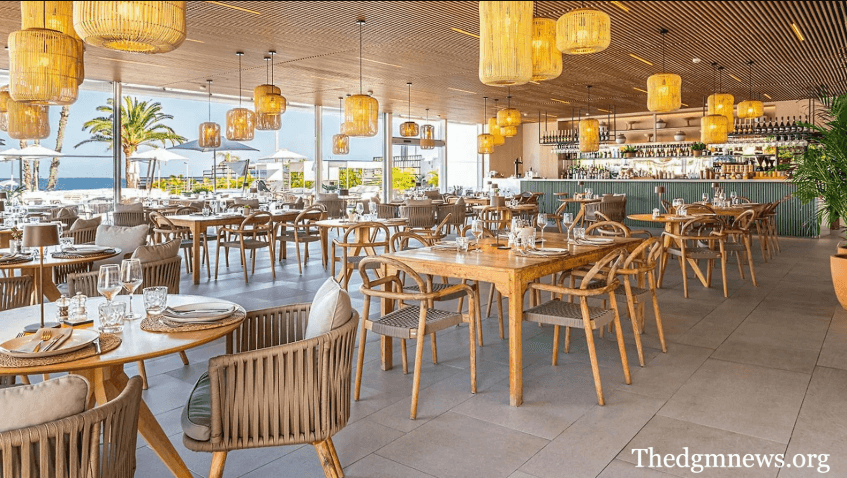Introduction
Imagine sipping champagne while seated in a warm, bubbling Jacuzzi—your favorite gourmet dish served just inches away. No longer a fantasy, this fusion of hydrotherapy and fine dining is becoming a global sensation.
Welcome to the Jacuzzi restaurant—an immersive culinary trend redefining what it means to dine in style. This innovative concept combines wellness, luxury, and gastronomy, creating a sensory experience unlike any traditional restaurant can offer.
This article explores the essence of Jacuzzi dining, its evolution, cultural significance, business model, and why it’s fast becoming the must-try experience for modern diners.
What Is a Jacuzzi Restaurant?

A Jacuzzi restaurant integrates hot tubs (Jacuzzis) into the dining environment, allowing guests to eat while soaking in a bubbling bath. It’s a multi-sensory experience that merges the therapeutic benefits of hydrotherapy with culinary indulgence.
Key Features:
- Private or shared Jacuzzi seating
- Waterproof menus and floating trays
- Upscale meals and beverages served poolside
- Mood lighting, music, and ambiance tailored for relaxation
- Spa-inspired environment with high hygiene standards
The Evolution of Jacuzzi Dining
From Spa to Supper
The Jacuzzi itself dates back to the early 1900s, originally designed for hydrotherapy. However, the concept of using a Jacuzzi as a dining space is a 21st-century innovation, primarily driven by:
- The rise of experiential dining
- Increased demand for wellness-centered leisure
- Social media trends encourage shareable moments
Global Hotspots
Some of the earliest Jacuzzi dining experiences appeared in luxury resorts in Japan, the UK, and the Netherlands. Notably, the HotTug in Rotterdam—a floating Jacuzzi boat—set a precedent for merging water-based leisure with casual dining.
Jacuzzi Restaurants vs Traditional Restaurants
| Feature | Jacuzzi Restaurant | Traditional Restaurant |
| Ambience | Spa-like, relaxing, immersive | Varies: casual to fine dining |
| Seating | In a hot tub | On chairs or booths |
| Food Service | Waterproof trays, floating tables | Standard table service |
| Target Audience | Experience-seekers, luxury diners | General public |
| Hygiene Protocols | Very strict, water testing, and robe handling | Standard food safety |
Benefits of Dining in a Jacuzzi Restaurant
1. Multi-Sensory Engagement
Combining the taste of gourmet food, the touch of warm water, and soothing audio environments heightens overall satisfaction.
2. Stress Relief
Jacuzzis naturally improve blood circulation, reduce stress, and alleviate tension, making diners more relaxed and receptive to taste.
3. Social Experience
Jacuzzi dining is popular for:
- Date nights
- Birthday celebrations
- Bachelorette parties
- Group outing
4. Aesthetic Appeal
With Instagrammable setups, Jacuzzi restaurants attract influencers and travel bloggers, enhancing brand visibility.
Challenges and Concerns
1. Hygiene and Cleanliness
Maintaining sanitized tubs is crucial. Restaurants typically follow:
- Daily water filtration and disinfection
- Disposable robes and towels
- Staff hygiene training
2. Food Safety
Keeping food dry, uncontaminated, and fresh in a steamy environment requires:
- Sealed containers or cloches
- Elevated trays or floating surfaces
- Prompt service timing
3. Privacy Issues
While many restaurants offer private Jacuzzi booths, others operate in shared spaces, which can be less comfortable for introverted guests.
Design & Architecture of Jacuzzi Restaurants
Interior Elements:
- Non-slip flooring
- Ambient lighting (LED, soft tones)
- Waterproof furnishings
- Ventilation and temperature control
Innovative Seating Layouts
- Sunken Jacuzzis integrated into floors
- Pod-style units separated by frosted glass or curtains
- Open-deck setups in outdoor spaces
Safety Measures:
- Temperature-regulated water
- Anti-slip mats and emergency buttons
- Staff supervision in case of discomfort or spillage
What Kind of Food Do Jacuzzi Restaurants Serve?
Menu Specialties:
- Gourmet finger foods (canapés, sliders, sushi rolls)
- Spa-inspired meals (light salads, grilled seafood, organic ingredients)
- Exotic desserts (fruit platters, chocolate fondue)
- Signature drinks (mocktails, prosecco, herbal teas)
Tips for Jacuzzi Dining:
- Avoid oily or heavy dishes
- Opt for easy-to-eat items
- Stay hydrated with infused water or light beverages
Target Audience and Demographics
Jacuzzi restaurants mainly cater to:
- Young professionals (ages 25–40)
- Luxury travelers
- Couples seeking romantic outings
- Health and wellness enthusiasts
- Social media influencers
They’re especially popular in urban centers, resort destinations, and high-income markets.
Why Entrepreneurs Are Investing
High ROI Potential
Combining dining with wellness allows for premium pricing. Average bills per head are significantly higher than traditional restaurants.
Brand Differentiation
Unique experiences attract repeat customers and brand loyalty.
Strategic Partnerships
Opportunities exist for collaboration with:
- Luxury spas and wellness brands
- Boutique hotels
- Event planners (e.g., romantic packages)
Actionable Tips for Visiting a Jacuzzi Restaurant
- Book in Advance – Seats are limited due to private arrangements.
- Dress Accordingly – Swimsuits required; robes and towels usually provided.
- Mind the Etiquette – Keep phones protected and avoid splashing.
- Limit Alcohol – Hot water intensifies alcohol absorption.
- Stay Hydrated – Balance luxury with safety.
Real-World Examples of Jacuzzi Restaurants
1. Bota Bota Spa-sur-l’Eau – Montreal, Canada
A floating spa with gourmet restaurant service onboard.
2. HotTug – Netherlands
Floating Jacuzzi boats offering wine and finger foods on canals.
3. RAKxa Wellness – Thailand
Combines hydrotherapy with custom nutrition-based menus.
Conclusion
Jacuzzi restaurants are more than a novelty—they represent a new direction in experiential dining. As wellness becomes a priority and consumers seek deeper emotional connections with leisure, these hybrid establishments are uniquely positioned to thrive.
Offering a blend of culinary excellence, relaxation, and aesthetic pleasure, Jacuzzi restaurants promise a memorable escape from the ordinary.
Whether you’re a wellness traveler, a romantic couple, or simply curious to try something new, this luxurious dining experience may just be your next unforgettable night out.
FAQs
What should I wear to a Jacuzzi restaurant?
Swimsuits are typically required. Most restaurants provide towels and robes.
Is it safe to eat in a Jacuzzi?
Yes, when proper hygiene and food safety protocols are followed.
Are Jacuzzi restaurants suitable for families?
Some are adult-only, while others offer family-friendly seating—check the policy before booking.
How much does it cost to dine in a Jacuzzi restaurant?
Prices vary, but expect higher-than-average bills due to the premium experience—often ranging from $75 to $200+ per person.
Do I need a reservation?
Absolutely. Due to limited Jacuzzi seating, booking in advance is highly recommended.



